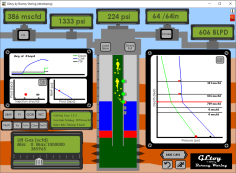
GLtoy Documentation
(Version: 3 April 2018)
Copyright 2018 Burney Waring
Copyright 2018 Burney Waring
Installing GLtoy
Using GLtoy
GLtoy Cases and Challenges
GLtoy Construction
GLtoy License
Contact Burney Waring
You have the GLtoy!
GLtoy is an educational software toy, created by me, Burney Waring (copyright 2018).It is free for non-commercial use, but not for commercial use. See the License information.
The Latest version of this documentation will be online.
Latest Version of GLtoy to download.
If you have installation problems, have a look here:
http://waringworld.com/gltoy/Installing_GLtoy.html
What is GLtoy?
I have taught a wide variety of Petroleum Engineering courses to thousands of engineers, on topics such as Production System Optimization, Integrated Modeling, Gas Lift, and Electric Submersible Pumps (ESPs).And, I wrote a book that I think you would enjoy, called Practical Optimization of Petroleum Production Systems, which you can purchase from Amazon.
More about me here and here.
During my time teaching, I found it is very difficult to teach how dynamic systems (such as gas lift wells) react to changes. I did my best with whiteboards and slide decks, but it was very difficult and sometimes I failed. For this reason, I created GLtoy.
[ I created a similar program for Shell in 1998(!) that some people have requested from me over the past few years(!!). GLtoy is much better. :) And it will run on Windows 10. ]
This is not an engineering model that can be used for design and analysis, but it does (mostly) behave the way a gas lift system would work and can be useful to understand gas lift well unloading, kickoff, instability, gas lift design for existing installations, design of mandrel spacing, the effect of wellhead choking, the effect of choking gas lift valves, gas lift performance, the effect of productivity on design and operation... Most of the information you would care to know about gas lift. Using GLtoy could be the basis of a whole course on gas lift operation, analysis and design.
GLtoy is very realistic in the most important ways, but is not accurate in the sense that you can use the data from it for engineering purposes. It is not a dynamic simulator that you can use to check your own designs, for example. The only reason it can work is that most of the important, time-based parts happen on the tubing-casing annulus. There are effects that a real dynamic simulator would predict in the tubing, for example tracking through each segment the amount of gas bubbles rising, that happen quite quickly compared to the tubing-casing annulus. So, ignoring these is not correct, but leaves a realistic-looking simulation. Well, enough to be helpful, anyway. Another effect that is not included here is gas lift unloading valve performance. The actual performance of gas lift valves has been researched, but this research is not distributed widely and is difficult to use in design and analysis without appropriate software. GLtoy also does not include accurate temperature prediction, PVT models, and more. So, don't use it for real work. Okay?
Remember this is a work-toy. Have fun with it. Then go use a real GL analysis and design tool to do actual work. For example: WinGLUE.
I also have published a similar program for ESPs. ESPtoy can be found here.